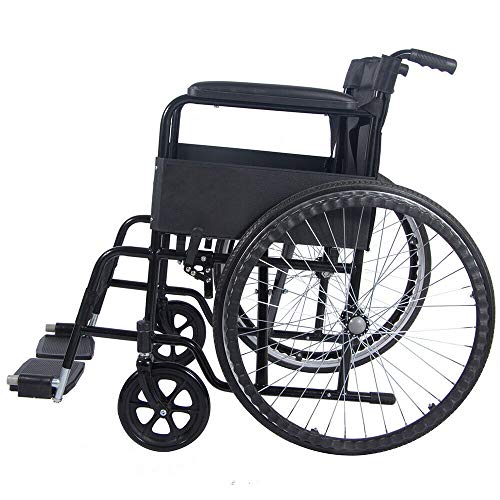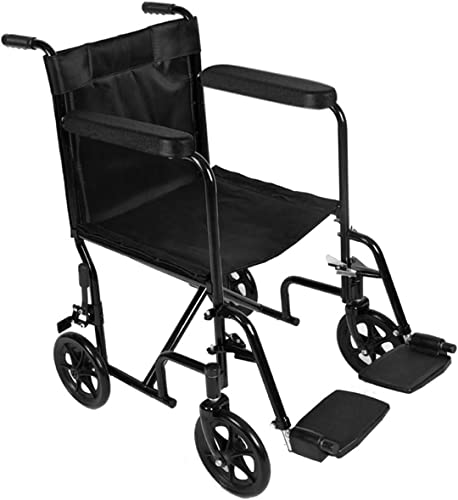Wheelchair With folding travel wheelchair Arms
 A wheelchair that has arms that fold allows for greater versatility and ease of use. This feature allows the chair to fold horizontally, which reduces its size and making it easy to transport and store in vehicles.
A wheelchair that has arms that fold allows for greater versatility and ease of use. This feature allows the chair to fold horizontally, which reduces its size and making it easy to transport and store in vehicles.
Many of these wheelchairs have elevating footrests with a swing-away and padding nylon upholstery. They also come with 8″ 1-inch solid front casters that provide smooth and durable gliding across most surfaces.
Vertical Folding
Wheelchairs are designed with numerous features to provide security and comfort. For example, they often have an adjustable lumbar support. This lets the user alter the height of the support so that it is more in line with their spine and can ease pain from pressure on different parts of their body, including the spine, coccyx and bottom.
The ability of a wheelchair to switch from manual to power mode is a standard feature. This is done by flipping an lever on the back wheels. This will turn the chair in manual mode, which means that it won’t be powered by motors and is more maneuverable. To power the chair, flip the lever away from the wheelchair.
Non-portable folding wheelchair wheelchairs are usually constructed with sturdy frames that provide high stability and durability. These chairs are used for long periods of duration and must be durable. These chairs are a great option for those who require a wheelchair to support lots of weight.
The disadvantage of models that do not fold is that they occupy more room in cars than folding models. This can be a problem if you don’t have an automobile with the capacity to hold the wheelchair. Additionally the weight of a non-folding wheelchair can be a problem for caregivers to lift and transport.
Folding wheelchairs, on other hand, are a great option for individuals who have to move their chairs regularly. They are constructed with the ability to collapse their cross frame, which makes them easier to transport in the car. They also tend to be lighter than the ones that are not folding, which can make them easier for caretakers to lift and move.
The invention described hereinafter provides a vertically-foldable wheelchair that includes a resilient stop assembly. The stop assembly consists of two side frame assemblies, each mounted rotatably to the upper frame member, and each having a first stable position on the other side of a linkage assembly’s centerline. The linkage assembly is biased toward the first stable position and is sufficiently resilient to retain the side frame assemblies in the deployed condition until the occupant selectively-manipulates the linkage assembly.
Horizontal Folding
This type of wheelchair folds horizontally, making it easier to put in a car. This is the preferred chair of those who have to be mobile and able to fit into vehicles with low roofs. It is also a great option for those with little space in their home or car.
This unique wheelchair comes with lightweight frames that are easy to fold, lift and move. The wheelchair is available in a variety of configurations. It is available with height-adjustable arms and legrests that swing out. The upholstery is covered with nylon to resist the growth of bacterial and mildew and side panels that prevent the legs from sliding down into the wheels.
Advanced wheelchair users can remove their rear wheels from the chair when seated, making it easier to navigate through doors and other small spaces. This also lets them change the tires for ones that are more suitable for their new surroundings or if they plan to take on more outdoor activities.
 The various types of wheelchair folding (Read the Full Guide) can be classified based on the direction of the hinge and axial surface as well as their degree of tightness. (Gentle folds open folds; close folds; isoclinal foldings; overturned, recumbentfolds). Each category serves a specific function, such providing traction or preventing scratching.
The various types of wheelchair folding (Read the Full Guide) can be classified based on the direction of the hinge and axial surface as well as their degree of tightness. (Gentle folds open folds; close folds; isoclinal foldings; overturned, recumbentfolds). Each category serves a specific function, such providing traction or preventing scratching.
Some wheelchairs tilt, which is helpful for those with a poor sitting ability and at risk of skin ulcers. This kind of wheelchair is typically called a “tilt-in-space” wheelchair, and it’s designed to offer the user the most comfort by spreading their weight evenly across the seat. It is often used by those suffering from spinal cord injuries or cerebral palsy, as well as muscular diseases who can’t use their legs. It’s an excellent choice for individuals who need a way to ease the pressure on their bones as well as prevent pressure sores. It also helps people with dizziness and scoliosis to feel more stable in their chairs. To tilt the chair, a switch usually located at the bottom of the chair. It is pressed to activate.
Quick-Release Wheels
The quick-release wheel system decreases the weight and size of a wheelchair when it is taken apart, and also permits easy inspection of the wheels and mounting of new tires. It is comprised of a small rod, called the skewer, which goes through the axle, and an elongated cam lever that is positioned over the wheel to hold it in place. These systems are operated by pressing the lever with your palm. There are two primary types of quick-release axles: the standard and a larger diameter version that is threaded into the frame. It is known as a through-axle.
Make sure to adjust the skewer as well as the cam before using a quick release. The narrow end of the springs must rest against the axle ends, and when you tighten the skewer it must fit in the recess on the inside side of the cam or the adjusting nut. Otherwise, it will bend. You can test this by spinning the spring with the adjusting nuts loose and looking for a wedge-shaped gap between the wide end of the skewer and the inner faces of the axle locknuts.
You may have to open the lever, and then close it using some force. The lever should be so tight that it leaves an impression on your palm and is sturdy enough to hold the wheel securely.
A few cheap quick-releases have plastic parts that lessen the force required to clamp the wheel. Also, some skewers that are cheap are made of lower quality steel, so they can be more susceptible to corrosion.
The lever should be placed in a way that it is in a straight line with the frame and has a curved form that stops it from snagging on anything. Even though it may appear that the lever is holding the wheels, a protruding lever signifies that it’s not completely closed. If it is knocked into something, a protruding wheel lever can loosen. To avoid this happening, you must ensure that the lever is secured and shut before every ride.
Removable Arms
There are many types of wheelchair arm designs available that can be flipped or removed completely. Some wheelchairs can be adjusted in height to accommodate lap trays. Others can have single-sided arm rests to support an office-like posture. Armrest pads are available in a variety of materials such as hard plastic, self-skinned composite or padded fabric. They are also available in a range of colors, including the standard silver vein.
There are wheelchairs that do not have armrests for those who don’t wish to use them. They can put their arms along the side of the chair. This can increase the functionality and make it easier to sit at a table or desk and some active wheelchair lightweight folding users might find that armrests hinder their independence or cause discomfort due to being too low.
If you do not have an armrest, your arms can pull your torso forward and cause you to lean forward, and then adopt a slouched position. Armrests assist in taking the weight of gravity off your arms and shoulders and allow you to support a tray or hold on to items with both hands.
Some wheelchairs have a fixed-height armrest that is not able to be turned up or taken off. This kind of armrest can be used to support a tray or for moving. It is usually too low to provide adequate arm support and may cause discomfort.
Other models of wheelchairs feature adjustable rigging that can be removed when not required, and this can decrease the weight of the model, making it easier to move or transport. Certain models of wheelchairs feature a lighter frame with breathable seating material, as well as Mag spokes.
Wheelchairs with rigging that can be removed are lighter than their collapsible counterparts. They provide the same top quality, durability and safety that other mobility devices offer however, they have the added benefit of a smaller frame which allows for easier maneuvering in tight spaces and also for transportation.
